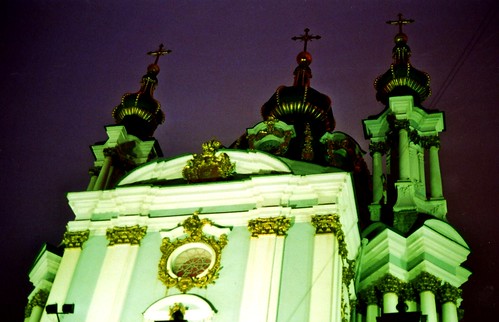Ya Gallery gör skillnad
Category: art, by sophie engström, ukraina, ukraine
Tags: art, gallery, Gudimov art project, homosexuality, Pavlo Gudimov, Ukraine, Volokitin Artem, Ya gallery
Att Ya Gallery är något utöver det vanliga står helt klart efter bara en kort stunds möte med dess grundare och ledstjärna Pavlo Gudimov. För Pavlos ambitioner för Ya Gallery är allt annat än ringa. Han vill sätta stora avtryck, inte bara här och nu, utan även i en mycket avlägsen framtid.
Men i höstas hamnade galleriet i helt oväntat i rampljuset när det brändes ned av en uppretad folksamling. I efterhand har det uppstått ett rykte att det var en utställning om homosexualitet som orsakade attacken, men så var inte fallet. Orsaken till folkmobben vrede var att Ya gallery lät husera en paneldebatt om situationen för homosexuella i dagens Ukraina ledd av en Gay organisation.
– De hade ingenstans att ha sitt möte, och vi såg inget hinder med att låta dem använda vårt galleri för deras paneldebatt. Men tydligen var det för känsligt, förklarar Pavlo. Jag är ganska säker att något liknande aldrig skulle kunna hända i Sverige, avslutar han.
Den unge konstnären Volokitin Artem, som ställde ut vid tillfället för attentatet, behandlar inte homosexualitet, även om hans verk vid en snabb betraktelse kan vara något provocerande, men knappast genom att det tangerar ett homosexuellt tema.
Artem Volokitin får PinChukArtPrize
Pavlo menar dock att både Artem och Ya Gallery har fått upprättelse och till och med tjänat på attentatet. Båda fick uppmärksamhet och fick därför en ny publik. Men de homosexuellas situation är oförändrat svår, så där har inte positivt hänt, säger Pavlo.
Ya Gallery har funnits i tre år, men Pavlo har drivit andra verksamheter tidigare. För 8 år sedan grundade han en design workshop, eller showroom. Det är kanske Ya Gallery har en så bred bas. Pavlo har med företaget Gudimov art project knutit fem företag till sig. De är förläggare, designer eller sysslar med samtida konst på något annat vis. På det sättet kan de sköta hela marknadsföringskedjan för Ya Galleri och Pavlo menar att ett stort problem för samtida konst är att det inte finns någon infrastruktur fört konst och konstnärer. Pavlo poängterar också att korsbefruktningen mellan de olika disiplinerna inim Gudminov art project är mycket viktig. Det skapar en kreativ miljö och nya tankar skapas. Dessutom är publikationer Gudminov art projects största inkomsts källa och det är den som hjälper Ya Gallery att existera.
Ya Gallery med Pavlo Gudminov i spetsen, vill förändra, påverka och även i viss mån anvgöra hur den ukrainska konstscenen borde se ut i framtiden. Pavlo åker runt i landet för att söka upp konstnärer, unga eller gamla spelar ingen roll. Det viktiga för Pavlo är att inte trampa i redan upptrampade spår. Han vill inte heller favorisera ett fåtal konstnärer.
– Många gallerier kör bara med runt 10 konstnärer, men jag vill ha en bredare bas än så, säger han.
Han räds inte heller att ta en helt oprövade kort. Just i skrivande stund ställer de ut två till åren komna konstnärer. De har aldrig ställt ut tidigare, men det hindrar inte Ya Gallery.
– De har ett uttryck som passar vårt koncept, säger Pavlo.
– Vilket koncept, måste jag då fråga. Att det är “ukrainskt” och passar en undertitel “contemporary Ukrainian art”?
– Nja, säger Pavlo. Termen “contemporary Ukrainian art” är ett försök att ge ukrainsk konst ett spelrum eller utrymme. Och jag vill ju vara med att skapa innehållet i det utrymmet.
– Men är inte “ukrainskt” bara ett ord på modet här i Ukraina? Vad händer om det plötsligt blir föråldrat eller riktigt töntigt?
– Ja, jag kan erkänna att det är sant, och att vi i viss mån använder det som smart marknadsföring. Det ger rätt känsla, så att säga. Vi ställer ju dessutom ut internationella konstnärer, ler Pavlo. Men det råder också en enorm okunskap om Ukrainas konstscen, både inom och utom landets gränser. Kan vi vara med och skapa en kunskapsbrygga mellan konstnärerna och deras publik, så är jag nöjd, avslutar Pavlo innan han hastar iväg till nästa möte.






